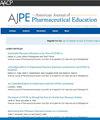Evolving Standards: An Examination of NAPLEX Blueprint Changes and Implications for the Academy
IF 3.8
4区 教育学
Q1 EDUCATION, SCIENTIFIC DISCIPLINES
引用次数: 0
Abstract
Objective
To examine changes in the North American Pharmacist Licensure Examination (NAPLEX) blueprint from 2007 to 2025 and identify trends in the blueprint competencies and their alignment with curricular standards.
Methods
Members of the research team created a crosswalk using the 2025 NAPLEX blueprint as the reference year, to which they mapped the 2007, 2016, and 2021 blueprints. The crosswalk was distributed to several other assessment and curriculum colleagues at various institutions, public and private, for iterative review and revision until consensus was reached. The same process was used to map the 2025 blueprint to Curriculum Outcomes and Entrustable Professional Activities 2023.
Results
New NAPLEX subdomains in 2025 include immunization, ethics, and mentorship/preceptorship. Notable differences in blueprints include structural changes in content moving from separately identifiable areas (ie, math and compounding) and into a collective domain with other content and reducing formulation-related content while increasing clinical content. The latter aligns with a substantial amount of content mapping to the “provider” and “problem-solver” curricular outcomes and the clinical sciences, particularly, medication use processes, area of Accreditation Council for Pharmacy Education Standards 2025 Appendix 1.
Conclusion
The 2025 NAPLEX blueprint resembles a shift toward clinical content in comparison to previous blueprints. Curricular outcomes related to solving problems; providing whole person care; and stewardship of medication systems for prescribing, order processing, dispensing, administration, and effects monitoring align with the new NAPLEX blueprint.
不断发展的标准:NAPLEX蓝图的变化及其对学院的影响。
目的:研究北美药剂师执照考试(NAPLEX®)蓝图从2007年到2025年的变化,并确定蓝图能力的趋势及其与课程标准的一致性。方法:研究团队成员使用2025 NAPLEX®蓝图作为参考年创建了一个人行横道,并绘制了2007年、2016年和2021年的蓝图。这条人行横道被分发给其他几位公立和私立机构的评估和课程同事,让他们反复审查和修订,直到达成共识。同样的过程也用于将2025蓝图映射到课程成果和可信赖的专业活动(COEPA) 2023。结果:2025年新的NAPLEX®子领域包括免疫、伦理和师徒关系。蓝图中值得注意的差异包括内容的结构变化,从单独可识别的领域(即,数学和复合)移动到与其他内容一起的集体领域,减少与配方相关的内容,同时增加临床内容。后者与大量内容映射到“提供者”和“问题解决者”课程成果和临床科学,特别是药物使用过程,ACPE标准2025附录1领域相一致。结论:与之前的蓝图相比,2025年NAPLEX蓝图类似于向临床内容的转变。课程成果涉及解决问题,提供全人护理,以及处方、订单处理、配药、管理和效果监测等药物系统的管理,与新的NAPLEX®蓝图保持一致。
本文章由计算机程序翻译,如有差异,请以英文原文为准。
求助全文
约1分钟内获得全文
求助全文
来源期刊
CiteScore
4.30
自引率
15.20%
发文量
114
期刊介绍:
The Journal accepts unsolicited manuscripts that have not been published and are not under consideration for publication elsewhere. The Journal only considers material related to pharmaceutical education for publication. Authors must prepare manuscripts to conform to the Journal style (Author Instructions). All manuscripts are subject to peer review and approval by the editor prior to acceptance for publication. Reviewers are assigned by the editor with the advice of the editorial board as needed. Manuscripts are submitted and processed online (Submit a Manuscript) using Editorial Manager, an online manuscript tracking system that facilitates communication between the editorial office, editor, associate editors, reviewers, and authors.
After a manuscript is accepted, it is scheduled for publication in an upcoming issue of the Journal. All manuscripts are formatted and copyedited, and returned to the author for review and approval of the changes. Approximately 2 weeks prior to publication, the author receives an electronic proof of the article for final review and approval. Authors are not assessed page charges for publication.

 求助内容:
求助内容: 应助结果提醒方式:
应助结果提醒方式:


